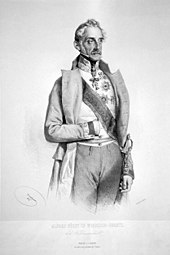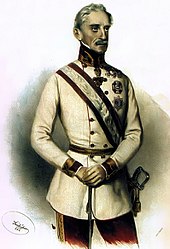Alfred I. zu Windisch-Graetz
Alfred Candidus Ferdinand Prince zu Windisch-Graetz (contemporary pronunciation with [a:]) (born May 11, 1787 in Brussels , † March 21, 1862 in Vienna ) was an Austrian field marshal .


Life
In 1574 the Windisch-Graetz family received the incolat in Bohemia . Associated with this was the ability to acquire land-related goods, the right to participate in the state parliaments and to apply for offices reserved for members of the state estates. The family seat became Tachau ( Tachov ) with the goods Kladruby , Steken and Mladejovice. Imperial Count Joseph-Niklas zu Windisch-Graetz (1744 to 1802) bought the Tachau estate on May 12, 1781.
Alfred I. Prince of Windisch-Graetz became first lieutenant in the 2nd Uhlan Regiment Schwarzenberg in June 1804 at the age of 17 . He took part in the Third, Fifth and Sixth Coalition Wars against Napoleon . During the Congress of Vienna he stayed in Vienna. On June 15, 1817, he married Eleonore Princess zu Schwarzenberg in Frauenberg, South Bohemia, and had seven children with her.
Best known is the role played by Prince Alfred I. zu Windisch-Graetz during the suppression of the democratic revolution in the Austrian Empire in 1848 and 1849, which made him a notorious figure among liberals and democrats. As city commander of Prague, he commanded the suppression of the Whitsun Uprising in Prague in 1848 (in which his wife was killed and his son Prince Alfred was wounded). Friedrich Engels reported in the "Neue Rheinische Zeitung" about the events in Bohemia and added: "The Austrian Soldateska has stifled the possibility of a peaceful coexistence of Bohemia and Germany in Czech blood."
During the October Uprising in Vienna , Alfred I. zu Windisch-Graetz was given the command of the Austrian emperor. On October 31, 1848, the military invaded Vienna under his leadership and helped the counter-revolution to victory. About 2000 deaths and considerable devastation were the result. The standing legal shooting of the politician and deputies of the National Assembly in Frankfurt Robert Blum in Vienna called it forth great indignation.
Its role during the Hungarian independence uprising in March 1849 is controversial. To put down the uprising, an imperial army under Alfred I, Prince of Windisch-Graetz , marched into Hungary and defeated the Hungarians in the battle of Kápolna . On April 10, 1849, the Austrian army had to withdraw from the revolutionary army, which was reinforced with free troops and Polish emigrants. After differences of opinion with the War Ministry, Windisch-Graetz was recalled by Emperor Franz Joseph I on April 12, 1849 and replaced by Ludwig Freiherr von Welden , whereupon he withdrew to his estates in Bohemia .
He also carried out various diplomatic missions, in 1859 as commander of the federal fortress became governor in Mainz and in 1861 a member of the Austrian manor house .
Prince Alfred I. zu Windisch-Graetz died on March 21, 1862 in Vienna and - like his wife Eleonore in 1848 - was buried in the Tachau family crypt in the Wenceslas Church. In 1886 his coffin was also transferred to the new family crypt in the monastery church of the Assumption of the Virgin of the Kladruby monastery. The monastery church is one of the most beautiful buildings in Bohemia and was built as a Romanesque basilica during the 12th century. Today's appearance in the so-called “baroque Gothic” style was designed by the Bohemian architect Jan Blazej Santini-Aichel in 1712 and 1726 .
Residences
Tachau Castle
During the rule of the Windisch-Graetz family, among other things, the complete reconstruction of the Tachau Castle in today's classical style, which began in 1787. In the nearby district of Heiligen ( Světce ), Alfred I zu Windisch-Graetz planned a large castle instead of the monastery church, although this plan was never completed. By the end of the 19th century, instead of the baroque monastery church, an impressive building with a neo-Romanesque facade and towers had been built. After the death of Prince Alfred I. zu Windisch-Graetz, his son did not continue the work on the castle, so that the building fell into disrepair over the next few decades. The neighboring riding arena has been preserved. The second largest riding arena in Europe, completed in 1859, has since been restored and is now used as a venue for the Bavarian-Bohemian Festival as part of the Bärnau-Tachov cultural summer on the Czech side.
Kladrau / Kladruby Castle
The Kladruby Monastery, which was secularized in 1785, near Kladruby in what is now the Czech Republic (German: Kladrau ), together with the large estate, was bought by Windisch-Graetz in 1825, although part of the purchase price did not have to be paid because of his services to the Austrian monarchy. The family's headquarters initially remained in the nearby town of Tachau ( Tachov ). In Kladruby, a brewery was built in the former monastery in 1864. When the family lost their property in Tachov as part of the land reform after the First World War, Ludwig Aladar moved from Windisch-Graetz to Kladruby and built an extensive library and the family archive here. In 1945 the Kladruby Monastery became state property.
Marriage and children
Prince Alfred zu Windisch-Graetz married on June 15, 1817 zu Frauenberg (Hluboká nad Vltavou) with Marie Eleonore Princess zu Schwarzenberg (born September 21, 1796 in Vienna, † June 12, 1848 in Prague). She was a daughter of Joseph II. 6th Prince of Schwarzenberg, Duke of Krumau, (born June 27, 1769 in Vienna, † December 19, 1833 in Hluboká nad Vltavou (Frauenberg) in Bohemia, buried in Třeboň (Wittingau) in Bohemia ) and his wife Princess and Duchess Pauline Caroline von Arenberg (* September 2, 1774; † July 2, 1810)
Children:
- Alfred II zu Windisch-Graetz 2nd Prince of Windisch-Graetz (1862–1876) (born March 28, 1819 in Vienna, † April 28, 1876 in Tachov), ⚭ October 19, 1850 Princess Maria Hedwig (Wixa) von Lobkowitz (* September 15, 1829 in Lemberg (Lwow); † October 19, 1852 in Tachov),
- Prince Leopold Viktorin Weriand (* July 24, 1824 - October 3, 1869) to Ostruvek u Tachova
- Prince August Josef Nikolaus (born July 24, 1828 in Prague; † August 29, 1910 in Schwarzenbach), kuk Privy Councilor a . Chamberlain, Colonel Silver Chamberlain u. Field Marshal Lieutenant. ⚭ June 2, 1853 Countess Wilhelmine von Nostitz - Rieneck (* April 23, 1827; † April 25, 1897)
- Prince Ludwig Josef Nikolaus (born May 13, 1830 in Vienna, † March 14, 1904 in Vienna), hereditary member of the Hungarian upper house, kuk Privy Council , general of the cavalry, troop inspector, owner of the 90th Inf.-Reg. Knight of the Order of the Golden Fleece etc. ⚭ February 8, 1870 in Pressburg (Bratislava) Countess Valeria Dessewffy v. Csernek et al. Tárkö (born October 8, 1843 in Budapest, † July 11, 1912 in Sárospatak)
- Prince Joseph Aloys Niklas (born June 22, 1831 in Prague, † October 18, 1906 in Vienna), Austro-Hungarian Privy Council a. Chamberlain, General of the Cavalry a. Captain of the First Arcieren Life Guard, owner of the 11th Hussar Regiment, ⚭ September 24, 1866 in Berlin Maria Taglioni “the younger”, Prima Ballerina of the Berlin State Ballet (* October 27, 1833 in Berlin; † August 27, 1891 Neu-Aigen with Tulln (Lower Austria)
- Princess Aglei Leopoldine Pauline (March 27, 1818 - July 6, 1843)
- Princess Mathilde Eleonore Aglei (* December 5, 1835 in Prague, † June 30, 1907 in Lieszko near Gablonz), kuk palace lady a. Lady of the Star Cross , ⚭ September 12, 1857 in Vienna her cousin, the Hereditary Prince Karl Vinzenz zu Windisch-Grätz (born October 19, 1821; † died in the Battle of Solferino on June 24, 1859)
Honors
- The Austrian Dragoon Regiment No. 14 , which he had owned since 1835, carried his name until the end of the monarchy in 1918.
reception
Due to the imperial resolution of Franz Joseph I on February 28, 1863, Alfred I, Prince of Windisch-Graetz, was added to the list of “most famous warlords and generals of Austria worthy of perpetual emulation”, and a life-size statue in their honor and memory in the Feldherrenhalle of the then newly established Imperial and Royal Court Weapons Museum (today: Army History Museum Vienna ). The statue was created in 1866 by the sculptor Raimund Novak (1827–1879) from Carrara marble and was dedicated by Emperor Franz Joseph himself.
literature
- Windischgrätz . In: Meyers Konversations-Lexikon . 4th edition. Volume 16, Verlag des Bibliographisches Institut, Leipzig / Vienna 1885–1892, p. 670.
- Constantin von Wurzbach : Windisch-Grätz, Alfred Candid Ferdinand Reichsfürst . In: Biographisches Lexikon des Kaiserthums Oesterreich . 57th part. Kaiserlich-Königliche Hof- und Staatsdruckerei, Vienna 1889, pp. 1–39 ( digitized version ).
- LW: Windisch Graetz, Alfred Candidus Ferdinand Fürst zu . In: Allgemeine Deutsche Biographie (ADB). Volume 43, Duncker & Humblot, Leipzig 1898, pp. 390-415.
- Gerhard Seewann : Windisch-Graetz, Alfred Fürst zu , in: Biographisches Lexikon zur Geschichte Südosteuropas . Vol. 4. Munich 1981, pp. 467-469
- Frank Raberg : Biographical handbook of the Württemberg state parliament members 1815-1933 . On behalf of the Commission for Historical Regional Studies in Baden-Württemberg. Kohlhammer, Stuttgart 2001, ISBN 3-17-016604-2 , p. 1021 .
Web links
- Alfred Candidus Ferdinand Prince of Windisch-Graetz (www.kuk-wehrmacht.de)
- Entry on Alfred I. zu Windisch-Graetz in the Austria Forum (in the AEIOU Austria Lexicon )
Individual evidence
- ↑ Neue Rheinische Zeitung No. 18 of June 18, 1848
- ↑ genealogy.eu: Windisch-Graetz family tree
- ↑ Johann Christoph Allmayer-Beck : The Army History Museum Vienna. The museum and its representative rooms . Kiesel Verlag, Salzburg 1981, ISBN 3-7023-0113-5 , p. 37 f.
| personal data | |
|---|---|
| SURNAME | Windisch-Graetz, Alfred I. zu |
| ALTERNATIVE NAMES | Windisch-Graetz, Alfred Candidus Ferdinand Fürst to |
| BRIEF DESCRIPTION | Austrian field marshal |
| DATE OF BIRTH | May 11, 1787 |
| PLACE OF BIRTH | Brussels |
| DATE OF DEATH | March 21, 1862 |
| Place of death | Vienna |


